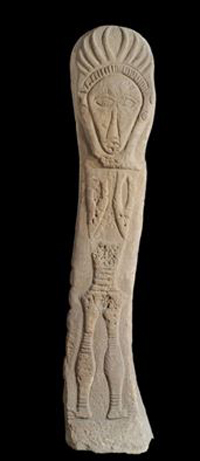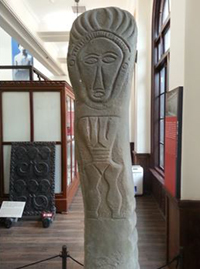:::
Legacies of NTU - No. 2
Remembering our Past: Indigenous Ancestral Stone Pillar in Museum of Anthropology
 The Double-faced Ancestral Stone Pillar is two meters tall and bears the image of the tribe’s first male and female ancestor on either side. The Museum of Anthropology is the second among the NTU Museums, and homes hundreds of thousands of ethnological and archeological artifacts. In the Indigenous Art display area, a large stone pillar that is up to two meters tall, 36 centimeters wide, and 15 centimeters in depth stands tall among the collection. This is the Double-faced Ancestral Stone Pillar of the Paiwan Tribe. The pillar was discovered during the Taihoku Imperial University, NTU’s Japanese predecessor, when researcher Utsurikawa Nenozo travelled to Pingtung County’s Pongari area (now Wangjia Village, Laiyi Township). The stone pillar was hidden among the bushes of a local indigenous settlement known as Karuboan, and after receiving permission from the tribe and government officials, the pillar was relocated to the university’s museum in 1929.
The monumental pillar is currently the only known item of its kind in the whole of Taiwan as the indigenous people of Taiwan have not produced many stone pillars, not to mention a double-faced carving of such dimension. The monument bears the carvings of a male and female ancestral figure on either sides. Both the figures are standing with their arms folded in front for their chests, and both are adorned with feather headdresses, patterned waist belts, and striped knee and ankle accessories. While the male figure is taller and slimmer than the female, the male sexual characteristic is now unrecognizable due to long-term weathering. Although the exact production date cannot be traced, viewing from the style and form of the carvings, it is deduced that the stone pillar is an extremely historical piece.
The Paiwan people are a hierarchical tribe where each tribal chief owns a unique emblem or rights to a specific totem. In addition, monuments of ancestral statues, such as the one stored in NTU, are only placed at the altar of the chief’s home as a sacred symbol of the family’s heritage. According to research, this particular stone pillar belonged to the Charoboyan family of the Karuboan settlement and the male and female carvings represent the Charoboyan family’s very first ancestors. It has als been reported that Pongari’s (now the Wangjia Village in Laiyi Township, Pingtung County) reknowned female chief Chaporan was also a descendant of the Charoboyan family.
 On the other side of the pillar is the carving of tribe’s first female ancestor who is significantly shorter than the male figure. The Double-faced Ancestral Stone Pillar of the Paiwan Tribe has has survived hundreds of years, and NTU has has the privilege of housing such a significant monument who in terms of history, craftsmanship, and culture is a true treasure and cultural heritage to the island's past.
See more of the Museum of Anthropology’s rich ethnological collection at their Facebook page.
Click HERE to access original article written by Museum of Anthropology (02/6/2014).
National Taiwan University is home to an abundance of educational and cultural artifacts that bear the history of the campus’ past. As a result, the NTU Museums project, a campaign that integrates the university’s ten individual museums, was launched in 2005 and officially inaugurated in 2007 so that the school’s hidden treasures could be introduced to the public. To honor the school’s past, the “Legacies of NTU” series will feature the stories of NTU’s hidden treasures by taking you through the most precious items among the university’s collection.
|



